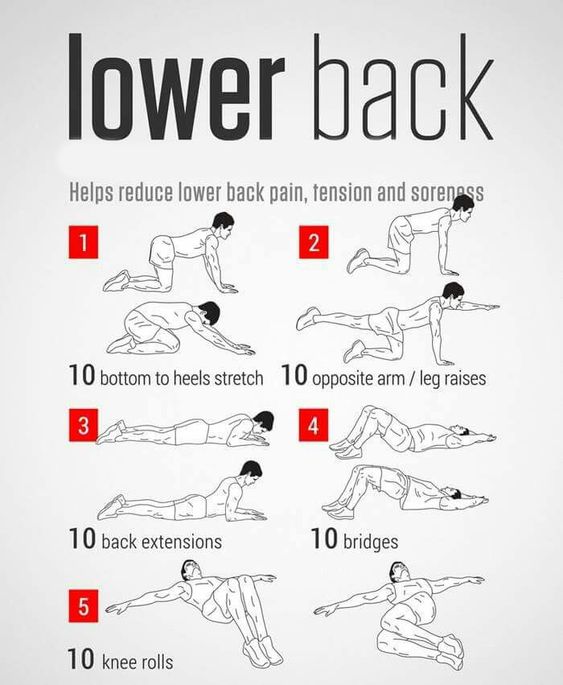If you have ever trained for a physical sport or been in the military, then you already know there is a right way and a wrong way to exercise.
When it comes to managing back pain, having a list of exercises is only the beginning. Unfortunately, many people that try back pain for exercise wind up getting worse because they fail to follow a few simple rules. Here are 5 things you must do to ensure your workouts are as safe and effective as possible.
Keep In Touch With Your Physical Therapist or Trainer
 As you search for exercises to relieve back pain, it is all too easy to follow wrong or bad advice. This may include faulty advice on how to carry out an exercise as well as which exercises will actually help your condition.
As you search for exercises to relieve back pain, it is all too easy to follow wrong or bad advice. This may include faulty advice on how to carry out an exercise as well as which exercises will actually help your condition.
It is very important to have a complete understanding of where the pain is coming from in your back. In some cases, there may be nerve damage along with bone and tissue damage. You may also be the victim of opiate painkillers that will make you think you are in pain even if there is no biological cause in your back.
Before you start on an exercise program, you should discuss it with your doctor and gain this person’s insight about how it will impact the actual cause of your pain. If you think the program might be of help, your next step should be consulting with a physical therapist or a fitness trainer that is certified in managing back pain. This is the person that can, and should help you with goal setting, and making sure that your exercise form is correct.
Contrary to popular belief, don’t expect to visit your trainer once or twice, and then simply go on with your exercise for years on end. You may need to see your trainer at least twice a week or more depending on how you are doing and changes to your program.
Make Sure Your Form is Correct
When I was in grade school, we were taught to do situps by putting our hands behind our necks. By the time I got to high school, the guidelines changed to keeping our arms folded in a self hug. Over time, experts realized that there is an increased risk of injury from using the older form of the exercise.
Even though you may be doing a particular exercise for some time, it never hurts to look up newer information on exercises and the correct postures to use while doing them. Your physical therapist or fitness trainer can also provide timely information.
Depending on the exercise, there may also be several variations to accommodate different strength and agility levels. If you are having problems with one form of the exercise, it may help to talk this over with your physical therapist to see if a modified form would be of help. It is better to use a modified form with good form instead of one that you cannot do properly.
Finally, it is also important to make sure that your body positions and postures are correct. You can use mirrors, video recorders, and your trainer watching to help ensure you are doing each exercise correctly. Taking classes can also be of help because you will have a chance to spot other people’s mistakes as well as receive immediate feedback about areas where you need to improve.
Do Not Overdo Weights or Repetitions
When you start to feel better or stronger, there is a normal inclination to want to try and do more. Unfortunately, if your muscles and joints aren’t ready, it can increase the risk of injury. You may also become overwhelmed when you can’t progress as much as you would like and wind up abandoning your efforts.
Instead of overdoing weights and repetitions focusing on your back, you can try other exercises. Here are some advantages to working on other parts of your body as part of your back relief routine:
- Some of your back pain may be coming from leg weakness that causes you to walk incorrectly. Therefore, when you build up the strength in your legs, it may actually enhance your back pain exercises.
- Many back pain problems occur because you wind up using your back to compensate for other weak muscles groups. If you lift something heavy, there is every chance that you will “throw your back into it” to compensate for arms or thighs that cannot handle the load on their own. Arm and shoulder exercises can increase your confidence in using these muscle groups and also help you reduce the amount of strain on your back when you have to lift or drag something heavy.
- Over the years, it is all too easy to fall into bad habits. This may include moving in ways that do more harm to your back than good. Depending on your level of fitness, gait training for walking and running may be of some help. Chances are you would be amazed at the number of tiny things you take for granted that may be contributing to your back pain. Even if gait training does not lead to decreased back pain, the increase in efficiency may be of use to you while you are trying to recover.
Choose the Right Shoes and Socks
If you have back pain because of an injury or accident, it is easy to overlook the fact that your feet may also be contributing to your misery. Worn shoes or arch supports that no longer meet the needs of your feet can easily make back pain even worse. Under these circumstances, using exercise for back pain may also result in failure.
Before you begin your exercise program, it may be of some help to see a podiatrist. At the very least, you can use the arch support analyzers in some shoe stores and department stores. Needless to say, if your shoes are worn, purchasing new ones along with good arch supports may be a good investment.
It is very important to choose good quality shoes and arch supports that you can wear during your exercise routine as well as at other times. Be sure to pick shoes that have good quality soles that will not slip or increase your risk of skidding.
Given the high price of good quality shoes these days, you may want to see if you can get shoes that are sturdy enough to withstand being repaired. Consider that a good pair of walking shoes may cost you almost $100.00 and last around 6 months if you do a lot of walking. A pair of shoes that can be resoled or repaired may cost another $50.00 or so. You will get that back because the shoes may last you 2 or 3 years.
Good quality socks are also very important. When your feet are slipping around inside your shoes because the socks are too slippery, it will not help your form while exercising. In a similar fashion, socks that are too heavy or too tight can easily cause circulation problems. To add insult to injury, poorly made socks may also have seams or other features that cause parts of your foot to rub in a way that cause callouses and other foot problems. All these things impact your gait when walking, and also your form while exercising for back pain.
Maintain Good Hydration
I am often amazed at the number of people walking around on hot days without carrying water. Other people will go to the gym with a fancy water cup, and then never touch a drop while they are working out. Good hydration is extremely important even when you are doing a short exercise routine. At the very least, if your program is broken up into 2 or 3 parts, you can use break time to drink some water.
As with any other exercise routine, the best thing you can drink is plain water. While some people use electrolytes or “sport drinks”, they can do more harm than good. Unless you are sweating heavily or working out for several hours a day, these drinks aren’t likely to do you much good. In fact, the caffeine and other additives in some sport or energy drinks can lead to high blood pressure, diabetes, and other health issues.
If you need something with a little fizz, try seltzer and add some natural flavorings to it. Today, there are also many alternatives to dangerous tap or bottled water. You can get a water pitcher to filter all the toxins out of the water. There are also home soda machines that you can use to make your own seltzers using the purified water.
Successfully relieving back pain can be challenging no matter what methods you try. Exercises for back pain can be very effective provided you get off to a good start and follow a few rules. While you may not think much about hydration and footwear, both can have as much impact on your ability to resolve back pain as the form you use when exercising and the program itself.








































































Some Real Good Points, Carmela ! With lots of back injuries, I read everything I see on this topic. Thank You. Bill